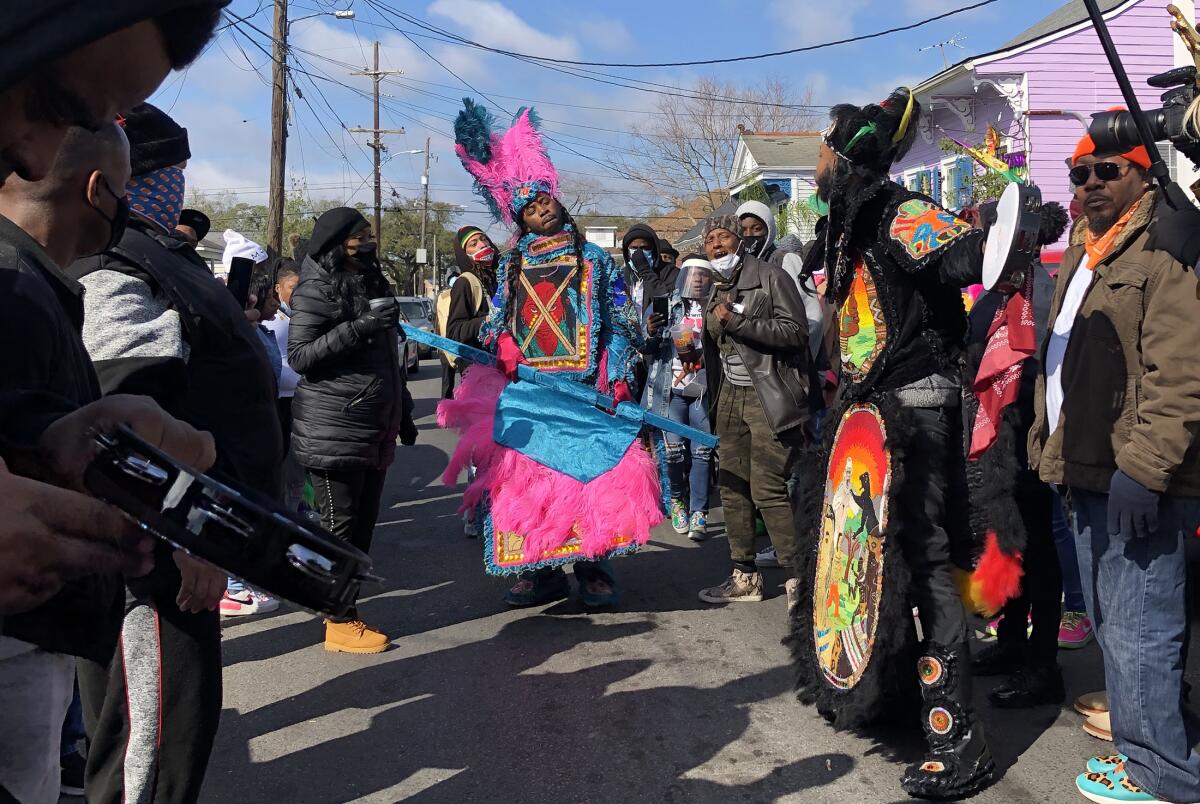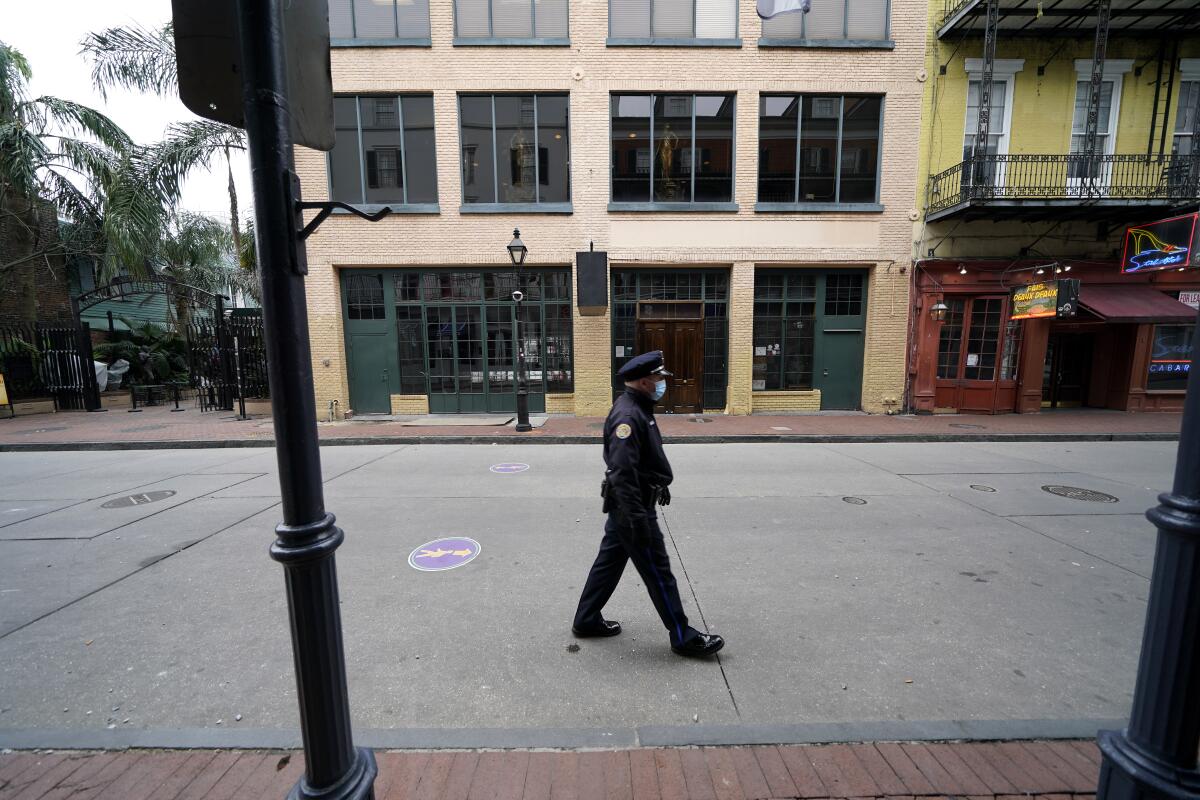‘A little bit of me wants to cry’: In New Orleans, a muted Mardi Gras

- Share via
NEW ORLEANS — As a frigid dawn broke here on Fat Tuesday — better known as Mardi Gras — the streets of Treme were unusually hushed.
No skeletons tromped through the historically Black neighborhood pounding on drums and knocking on doors to wake up residents and warn them of their mortality, a ritual that its practitioners say dates to 1819.
As a trickle of locals and tourists approached the Backstreet Cultural Museum, a tiny treasure trove of Black culture that is an early gathering point for the Northside Skull and Bone Gang, they found the front door shut and the lights off.
“No events will be scheduled on Mardi Gras day here due to COVID restrictions,” said a note scrawled on the porch. “Sorry.”
City officials decided it was not possible to celebrate Mardi Gras in a pandemic without strict rules to halt the spread of a virus that has killed nearly 750 people in Orleans parish and 9,325 across Louisiana. Memories are still fresh from March, when the carnival was derided as a superspreading event that turned the city into a coronavirus hot spot and overwhelmed its hospital emergency rooms.
The decision to cancel parades was made in November. But last week, amid reports of throngs of maskless revelers in the French Quarter, Mayor LaToya Cantrell closed all bars, banned all to-go drinks and ordered street closures in normally congested areas.

Many cultural leaders decided to not hold outdoor neighborhood gatherings.
Bruce “Sunpie” Barnes, the big chief of the Northside Skull and Bone Gang, started the day at home burning candles to honor the dead instead of donning a papier-mache skull and leading his usual procession.
“It’s unpredictable,” he explained. “You don’t know how many people are gonna show up.”
In March, Barnes lost the oldest member of his gang, Ronald Lewis, the director of the House of Dance & Feathers in the Lower Ninth Ward, to COVID-19.
Still, even as a deep freeze plunged Louisiana to record-low temperatures, a tiny crew of revelers rolled into Treme determined to mark the occasion. Just after 6 a.m., a woman in a skeleton suit and a shimmering white horse head strolled past St. Augustine Catholic Church.
A woman in a blue Subaru rolled down her window and blasted “Hey Pocky Away” by the Treme Brass and Indian Band, and a masked man in a blond wig and a baby doll suit wiggled his hips. For a few minutes, a tiny crowd began to shake and shimmy.
In neighborhoods from Faubourg Marigny to West Riverside, thousands of locals decorated their homes as parade floats, and many more sipped champagne and swigged beer. Some residents tossed gold, purple and green plastic beads to passersby from porches or roamed the streets in pink tutus and Mardi Gras capes, but most huddled inside as a winter storm brought temperatures that plummeted below 25 degrees.
“The whole city is in a grand funk right now,” said Arthur Hardy, a carnival historian who publishes the city’s annual Mardi Gras Guide. “There’s no model for this. We can’t ask ‘What did we do last time?’ There’s been no last time.”
New Orleans has scaled back on carnival before, suspending its big parades more than a dozen times since 1857 because of war, mob violence and labor disputes. After Hurricane Katrina breached the levees in 2005, flooding hundreds of thousands of homes and displacing more than half of the city’s residents, parade routes were shortened and the number of parade days cut.

But 2021 is the first time that the city has urged residents to scale back its more informal neighborhood celebrations, threatening to fine those who break the rules.
With bars shut, Bourbon Street transformed over the weekend from the bustling neon hub of the French Quarter to a drab, empty corridor. Claiborne Avenue, the historic meeting point for Black New Orleanians, was fenced off with metal chain link and flanked by police cruisers with flashing blue lights.
The restrictions were a particular blow for the city’s Mardi Gras Indians, tight-knit groups of Black working-class families who have kept alive a tradition of dressing in flamboyant suits in honor of Native Americans who helped protect runaway slaves.
For many, the celebration is an opportunity to connect with their ancestors, who dressed in elaborate suits to take their minds away from the realities of slavery and segregation.
“Most people look at Mardi Gras as a day where everyone is out there having fun, doing their thing, parading, getting drunk or what not,” said Victor Harris, 70, the big chief of the Spirit of Fi Yi Yi and Mandingo Warriors, who has donned ornate hand-sewn ceremonial suits of beads, shells and feathers for 55 years.
“It’s not just that for us,” he added. “Going back all the way from slavery, it’s a spiritual thing for us. This is the day to come together. This is a day where people feel free to be who they are and free to be who they want to be.”
Harris felt pulled to connect with his ancestors and offer healing to the community after nearly a year of a pandemic that has disproportionately affected Black residents. But he also recognized that his suits drew huge crowds.
“This heals the people and the people need the healing,” he said. “But I sure don’t want people getting sick following me out there. If I come out, a thousand people are going to follow me.”
In the Uptown neighborhood, Bo Dollis Jr., 40, big chief of the Wild Magnolias tribe, sighed as he got ready to bake BBQ ribs, pork chops and chicken and host a small party with his family and tribe at his mom’s house.
“Right now, it’s just a hard feeling,” he said. “A little bit of me wants to cry.”
But he understood why he couldn’t hit the streets after having nearly lost a member of Wild Magnolias to COVID-19.
“I have a mom, I have two little girls that can’t be out there,” he said. “I’d rather have them safe and have a future.”
Some tribes, though, did venture out in neighborhoods to showcase lavish new suits.
When the sun came out midafternoon, a swish of feathers was visible in the Seventh Ward as Jeremy “Lil Pie” Stevenson, 2nd chief of the Monogram Hunters, strutted up Touro Street in a towering suit of gold and blue beads topped with an enormous headdress of white and purple feathers.
As men beat African drums and tambourines, more than 100 Seventh Ward residents drew close, smiling and swaying and snapping photos with their cellphones.
“These guys have sewn suits all year,” said Lil Pie’s father, Big Chief Tyrone “Pie” Stevenson, who walked along in jeans and a sweater.
He accused the mayor of disrespecting his tribe last week when she held a news conference with just a handful of Mardi Gras Indian chiefs without including his downtown tribe. He told his men that he was not going to put on his suit this year, but he wouldn’t stop them from putting on theirs.
“This is our culture,” he said. “This thing here, what we do, saves lives. These guys could be out on the streets selling dope. They could be doing all kinds of criminal stuff, but they chose to stay at home and sew. At the end of the day, we deserve to be out here.”
More to Read
Sign up for Essential California
The most important California stories and recommendations in your inbox every morning.
You may occasionally receive promotional content from the Los Angeles Times.











